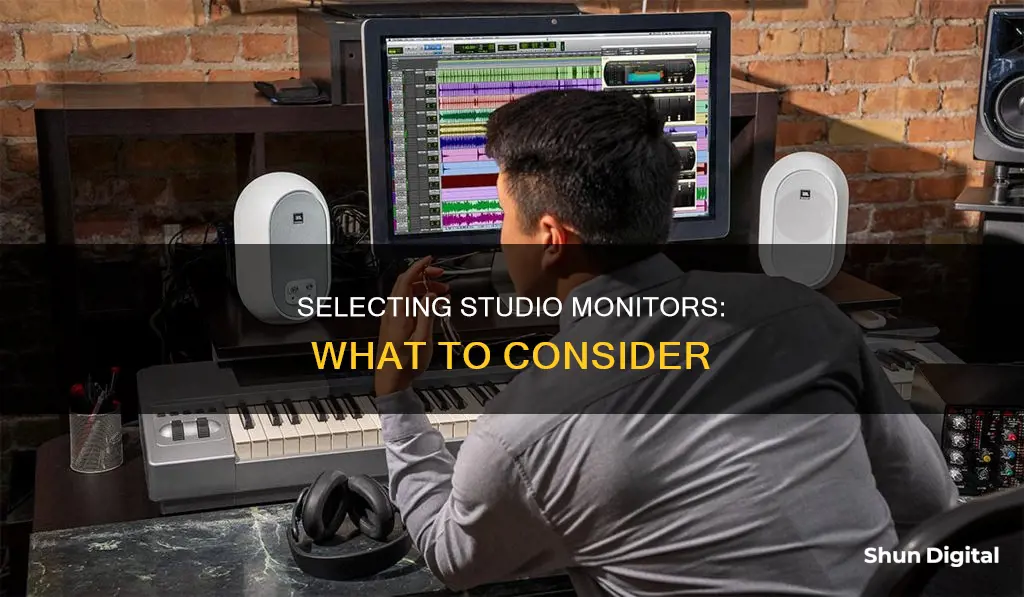
Choosing the right studio monitor is essential for audio creators, as it serves as the lens through which they hear their creations. While there is no one-size-fits-all solution, understanding the different types of studio monitors and their features can help you make an informed decision. Here are some key considerations to keep in mind when selecting a studio monitor:
- Active vs. Passive Monitors: Active monitors have built-in amplifiers, making them simpler to use, while passive monitors require external amplifiers, offering more flexibility.
- Two-Way vs. Three-Way Design: Two-way monitors have a tweeter for high frequencies and a woofer for mid-range and low frequencies. Three-way monitors add a dedicated mid-range driver, enhancing clarity and providing a more accurate representation of the critical midrange area.
- Room Size and Treatment: The size of your studio space will impact the type of monitor you need. Smaller rooms require smaller monitors to avoid muddling the sound with excessive low frequencies. Larger rooms call for bigger monitors that can provide adequate power and low-end response.
- Frequency Response: Look for monitors with a flat frequency response, ensuring that all frequencies are reproduced at the same volume level. This accuracy is crucial during the mixing stage of audio production.
- Portability: Consider whether you need to move your equipment, including monitors, between locations. If so, choose monitors that are designed to be portable and easy to transport.
- Budget: Studio monitors can range from a few hundred to several thousand dollars. Determine your budget and look for monitors that offer the best features and performance within your price range.
What You'll Learn

Active vs. passive monitors
There are two types of studio monitors: active and passive. Active monitors have built-in amplifiers, whereas passive monitors require external amplifiers. The choice between the two depends on your needs and preferences.
Active Monitors
Active monitors are simpler to set up and use as they don't require any additional equipment. They are also more reliable and accurate because the built-in amplifiers are specifically designed for and tuned to the monitors, which can lead to better overall sound quality. Active monitors are ideal for those who want an easy, plug-and-play solution.
Passive Monitors
Passive monitors, on the other hand, offer more flexibility. Since they don't have built-in amplifiers, you can choose an external amplifier that perfectly matches your monitors. This allows for a more gradual and cost-effective progression to better-quality gear. Passive monitors are a good choice for those who want more flexibility and are willing to put in some extra effort.
Considerations
When deciding between active and passive monitors, it's important to consider the size of your room and the type of music you work with. The size of the studio monitor driver depends on the room size and the music style. For example, if you produce EDM music, you will need better low-frequency response and a bigger driver size. On the other hand, smaller speakers may offer better midrange and high-frequency response for certain music genres.
Additionally, the wattage of the studio monitor is an important factor, as it determines the monitor's ability to deliver adequate sound levels without distortion. For beginners or small to medium-sized rooms, a studio monitor with 50-75 watts per channel is a good starting point. For larger commercial studios, a higher wattage of 100 watts or more per channel may be necessary.
Eliminating Monitor Noise: Simple Tricks to Reduce Screen Glare
You may want to see also

Two-way vs. three-way
Two-way or three-way? That is the question.
Two-way monitors are the simplest type of studio monitor you can buy. They refer to a design that includes a tweeter for high frequencies and a woofer for mid-range and low frequencies. The audio frequency range is divided into two parts: one for each driver type. The separation of these frequencies is controlled by the 'crossover', a system that supplies each driver with only the frequencies it has been designed to handle.
Three-way monitors add a mid-range driver to the design, thus providing a dedicated driver for the critical midrange area, which contains the sonic core of the most common instruments. A well-made three-way system will provide better insights into your audio and improve the stereo imaging as well. In a larger room, three-way monitors will cover a wider frequency range, and the increased dynamic headroom will mean you won't need to rely as much on headphones or subwoofers.
The choice between two-way and three-way monitors is also related to size – two-ways will be smaller, three-ways bigger. Many monitors will then be differentiated in terms of inches, generally 5 or 6 for two-way and 8 or 10 for three-way models. The difference in sizes will impact various aspects of the monitors, from their ability to provide clarity in the midrange to more accurately producing lower frequencies.
Two-way monitors are generally more affordable and can still provide excellent accuracy. They tend to be more power-efficient than three-way speakers and are often compatible with lower-powered amplifiers, which could result in both financial savings and a reduction in carbon footprint.
Three-way monitors, on the other hand, are likely to be more expensive due to their more complex crossover system and typically larger build. They are likely to deliver a fuller and more accurate sound, largely due to the extra crossover in the three-way system, which gives more attention to the middle frequencies. Three-way monitors are also likely to have better bass extension, furthering their accuracy.
The greater mid-range definition of three-way speakers also leads to more clarity and nuance in vocal performances, giving you a more realistic and holographic representation of the recording. However, sometimes, three-way speakers can sound more disjointed, meaning the blending of different frequency types isn't as smooth. It all depends on the quality of the crossover system.
So, which one should you choose? If you're on a low budget but want decent sound, two-way speakers could be the better choice. They're generally easier on the wallet and offer a great balance between cost and quality. Many people even prefer the sound of two-way speakers, meaning you can find great two-way speakers across a broad range of price points.
However, if you're willing to dig a little deeper into your pockets, you should also consider three-way speakers. With their more complex crossover system and typically larger build, they're likely to come at a higher cost. Remember, though, a top-notch pair of two-way speakers will often outperform a cheap, low-quality set of three-way speakers. So, if you're budget-conscious, sticking with two-way speakers can deliver more value for your money.
Choosing the Right Machine Screws for Monitors
You may want to see also

Digital vs. analogue
When it comes to studio monitors, there are two types of signal paths: analogue and digital. Monitors were analogue for most of the 20th century, but advances in technology mean that speakers can now utilise the flexibility of Digital Signal Processors (DSP). This difference impacts the monitor's signal path, or how it reproduces sound.
DSP-powered monitors have become more common in recent years, but as with any analogue versus digital product, there are excellent-sounding examples of both. Some believe that digital monitors can cause sonic degradation, but this is not always the case.
The Pros of DSP-Powered Monitors
DSP-powered monitors have several benefits, including:
- Quick and comfortable filter and equaliser settings.
- Piece-to-piece consistency for electrical filter values.
- Linear Phase filters (FIR) that allow control of the linear phase behaviour of the whole monitor (at the cost of signal delay). This can improve sound quality but introduce time delays.
- Room correction as an extension, only valid for fixed or narrow listening positions.
- Steeper filter characteristics up to 96 dB/oct, compared to 24 dB/oct for most analogue monitors.
The Cons of DSP-Powered Monitors
There are also some potential drawbacks to DSP-powered monitors:
- At least one, and in most cases, two additional A/D or D/A conversions will affect sound quality.
- There is potential for small distortion and noise issues compared to analogue designs.
Analogue Monitors
Analogue monitors have their own advantages and disadvantages. On the one hand, they may offer more flexibility in terms of coloration options, as the speakers can be given a specific sound based on amplification and internal components. On the other hand, analogue monitors may be limited by the performance of passive crossover components, and they may not offer the same level of amplifier control as their digital counterparts.
Ultimately, the decision between analogue and digital studio monitors depends on your specific needs and preferences. Both options have their pros and cons, and there are excellent-sounding examples of both types of monitors.
Monitoring Linux Server Performance: Key Metrics and Methods
You may want to see also

Room size and treatment
When choosing studio monitors, the size of your room is the most significant factor to consider. Smaller rooms, those under 16 square metres, will require smaller monitors to avoid low-frequencies muddling the sound. Near-field monitors are ideal for small spaces as they are designed to be placed close to the listener. These should have front-firing bass ports to reduce back-wall resonances.
For larger rooms, or rooms spanning 25-40 square metres, larger monitors are needed to cover the space and provide a reliable low-end response. Mid-field monitors are the best option here, providing the necessary power and accuracy.
Regardless of room size, room treatment is vital. Acoustic treatment can range from small improvements like bass traps to full acoustic optimisation and the use of room-correcting hardware. This ensures your monitors can perform to their full potential.
Frequency response is also impacted by room acoustics. To ensure accurate, flat frequency response, you may need to install panels, bass traps, and diffusers.
Removing Crosshairs: A Guide for MSI Monitor Users
You may want to see also

Accuracy and frequency response
When it comes to accuracy, it's important to remember that the room you're working in will always have an impact. The acoustics of the room, including issues such as reflection and resonance, can affect the frequency response of your monitors. To ensure accurate sound reproduction, you may need to treat your room with acoustic panels, bass traps, and diffusers. This will help minimise the impact of room acoustics on your monitors' frequency response.
Every monitor will come with a graph of its frequency response. A flatter line on this graph indicates greater accuracy. However, keep in mind that no speaker will ever have a completely flat line. Additionally, this data is obtained through laboratory testing and may not perfectly reflect how the monitors perform in your specific room. To ensure the best accuracy, use acoustical measurement programs to analyse and adjust your monitors for the flattest response possible.
The design of the monitor also plays a role in accuracy and frequency response. A 3-way or tri-amplified system, which uses three drivers to handle low, mid, and high frequencies, will typically provide greater accuracy than a 2-way or bi-amplified system. This is because each driver in a 3-way system is dedicated to a specific frequency range, allowing for more precise sound reproduction. However, 2-way systems are more common and can still provide excellent accuracy, especially for beginners and semi-professionals.
The size of the monitor and the size of the room you're working in also come into play. Larger monitors with larger drivers will generally have more headroom and can play louder, making them better suited for larger rooms. Conversely, smaller monitors are typically better for smaller rooms as they generate less low-frequency output that can muddle the sound. Additionally, the power of the amplifiers and the efficiency of the speaker enclosure will impact the volume and accuracy of the monitors.
In summary, when considering accuracy and frequency response in studio monitors, it's important to take into account the room you'll be working in, the design of the monitors, the size of the monitors, and the power of the amplifiers. By optimising these factors, you can achieve more accurate and reliable sound reproduction from your studio monitors.
Kindle Fire to Monitor: Easy Steps for Connection
You may want to see also
Frequently asked questions
The size of your room, the type of music you produce, and your budget are all important factors. You should also consider whether you need active or passive monitors, and whether a 2-way or 3-way design will better suit your needs.
Active monitors have built-in amplifiers, making them simpler to use and ideal for entry-level users. Passive monitors require external amplifiers, offering more flexibility but demanding more setup.
2-way monitors have a tweeter for high frequencies and a woofer for mid-range and low frequencies. 3-way monitors add a dedicated mid-range driver, improving accuracy and providing better insights into your audio.
This depends on your level of expertise. Beginners can find decent monitors for $200-$400, intermediate users should budget $400-$1000, and professionals might spend upwards of $1000 per monitor.







